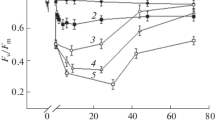Abstract
ILLUMINATION of chloroplast thylakoids leads to the formation of the so-called high energy state of the membrane1–3. The establishment of this state is accompanied by several structural changes within the membrane, including a conformational change in the coupling factor4, increased accessibility of photosystem II to the chemical probe p-diazonium benzene sulphonate5, and a reduction in the thickness of the partition between stacked thylakoids6. I describe here a rather different type of structural change that has not previously been reported for chloroplast membranes—protein phosphorylation. Like the above changes, protein phosphorylation is a reversible, energy-dependent membrane modification, but it differs from the other changes in that it takes the form of a specific chemical reaction involving certain identifiable chloroplast membrane polypeptides. The most conspicuous of these polypeptides is the light-harvesting chlorophyll a/b binding protein, the most abundant thylakoid polypeptide7.
Similar content being viewed by others
References
Barber, J. The Intact Chloroplast (Elsevier, Amsterdam, 1976).
Govindjee Bioenergetics of Photosynthesis (Academic, New York, 1975).
Anderson, J. M. Biochim. biophys. Acta 416, 191–235 (1975).
Ryrie, I. J. & Jagendorf, A. T. J. biol. Chem. 246, 582–588 (1971).
Giaquinta, R. T. et al. Archs Biochem. Biophys. 162, 200–209 (1974).
Murakami, S. & Packer, L. Biochim. biophys. Acta 180, 420–423 (1969).
Thornber, J. P. A. Rev. Pl. Physiol. 26, 127–158 (1975).
Hall, D. O. Nature new Biol. 235, 125–126 (1972).
Bennett, J. & Milewska, Y. in Genetics and Biogenesis of Chloroplasts and Mitochondria (eds Bücher, T. et al.) 637–640 (Elsevier/North-Holland, Amsterdam, 1976).
O'Farrell, P. H. J. biol. Chem. 250, 4007–4021 (1975).
Boulter, D. et al. Biol. Rev. 47, 113–175 (1972).
Chu, R. C. L. & Yasumobu, K. T. Biochim. biophys. Acta 89, 148–149 (1964).
Clegg, J. C. S. et al. J. gen. Virol. 32, 413–430 (1976).
Blair, G. E. & Ellis, R. J. Biochim. biophys. Acta 319, 223–234 (1973).
Bennett, J. Phytochemistry 15, 263–265 (1976).
Pai, M. S. et al. Protoplasma 85, 209–218 (1975).
Ralph, R. K. et al. Biochem. J. 130, 901–911 (1972).
Armond, P. A. et al. Archs Biochem. Biophys. 175, 54–63 (1976).
Davis, D. J. et al. Archs Biochem. Biophys. 175, 64–70 (1976).
Author information
Authors and Affiliations
Rights and permissions
About this article
Cite this article
BENNETT, J. Phosphorylation of chloroplast membrane polypeptides. Nature 269, 344–346 (1977). https://doi.org/10.1038/269344a0
Received:
Accepted:
Published:
Issue Date:
DOI: https://doi.org/10.1038/269344a0
- Springer Nature Limited
This article is cited by
-
Three-state mathematical model for the assessment of DCMU-treated photosystem II heterogeneity
Photosynthesis Research (2024)
-
Comparative analysis of thylakoid protein complexes in state transition mutants nsi and stn7: focus on PSI and LHCII
Photosynthesis Research (2020)
-
Comparative assessment of chloroplast transcriptional responses highlights conserved and unique patterns across Triticeae members under salt stress
Photosynthesis Research (2018)
-
Frequently asked questions about chlorophyll fluorescence, the sequel
Photosynthesis Research (2017)
-
The short-term response of Arabidopsis thaliana (C3) and Zea mays (C4) chloroplasts to red and far red light
Planta (2015)





